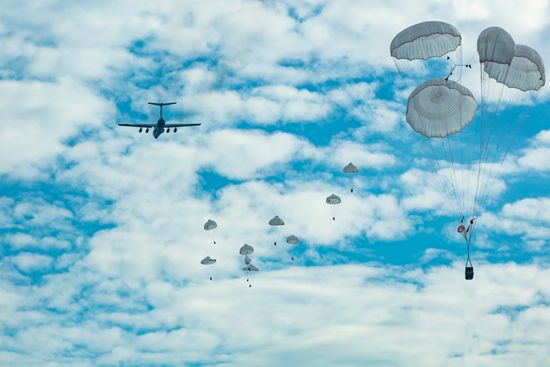
By Guo Qing and Jiang Long
BEIJING, May 7 -- A commissioning ceremony for a type of wheeled armored vehicle (WAV) independently developed by China was held in a combined arms brigade of the airborne troops under the PLA Air Force on May 6.
It's learnt that the WAV is qualified for aerial power projection by the PLA's main transport aircraft and can be used in conjunction with another tracked armored vehicle of the airborne troops. "The deployment of this new vehicle will fill in the blank left in the airborne force's wheeled armored equipment, and also marks that the mechanization and informatization construction of the PLA airborne force has reached a new level."
It is learnt that the airborne combined arms brigade is a new type of airborne combat force established after the latest military reforms in China. It includes 10-plus arms such as infantry, artillery, reconnaissance, communication and armored forces. However, further improvements are still needed for the PLA airborne force in the fields of system compatibility, structure optimization, information technology and system functions of the weapons and equipment.
According to Zheng Yingjun, commander of the airborne combined arms brigade, as an integrated combat system, the new WAV's vehicle-mounted command, control and communication system will enhance the troops' operational efficiency.
This year marks the 70th anniversary for the establishment of the PLA Airborne Force. The development of airborne weapons and equipment has also gone through a 70-year leap forward. For quite a long time after its establishment, the airborne troops were only capable of airdropping weapons or equipment within 120 kilograms.
"You have no place on the battlefield without strong firepower," said Wang Furong, one of China's first batch of 62 paratroopers. He remembered that when the airborne soldiers participated in the confrontation exercises involving the whole military forces at that time, they raced against the tank wheels all alone with their legs after landing, and confronted the "enemies" only with light weapons. But now, he said, "I'm so glad to see the new WAV get commissioned to the airborne troops. The dream of the airborne soldiers equipped with heavy equipment at the landing has eventually come true."
Airdropping heavy equipment is the foundation for airborne troops' mechanization and informationization construction. Li Zhenbo, a senior engineer who used to be the director of the Research Institute of Airborne Troops, said, "In the early 1990s when going abroad, we saw the self-evident gap between Russian and Chinese airborne forces. It had been a great stimulus for us."
Since then, the airborne troops have embarked on the road of heavy-armored mechanization. During this period, the airborne troops were designated as emergency combat forces of fast maneuver by China's Central Military Commission (CMC) and thereafter moved into the fast lane of development.
After a new round of military reform and remodeling in 2017, the PLA Airborne Force was incorporated into the joint operation system, and undertook the responsibility of implementing the air-ground integration operations with multiple services and arms in multiple strategic directions and battlefield environments. This has posed new and higher requirements for the support capability of its weapons and equipment.
The airborne troops focus on the development of new weapons and equipment in terms of air delivery, air assault, command and control, guided strike and so on, striding towards the informatization and systematization of weapons and equipment. With integrated joint operation of multiple services and arms being the underlying trend for future war, the airborne troops would be modularized in the joint operation system, either light- or heavy-armored, a senior officer of the airborne force said.

